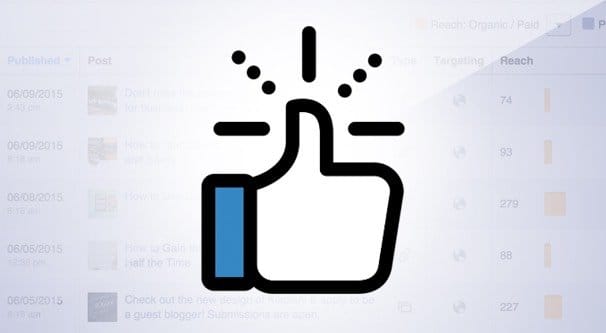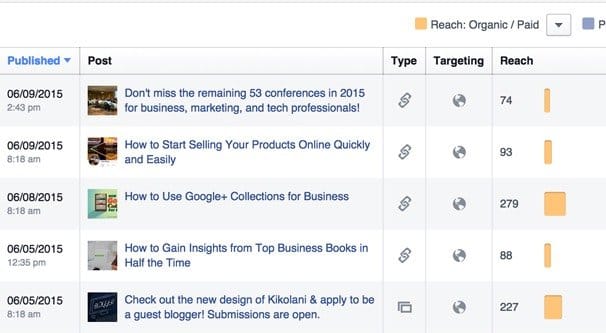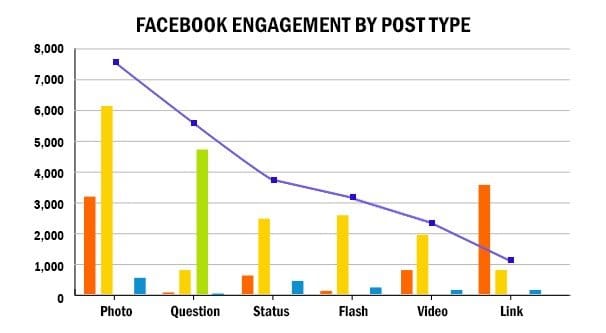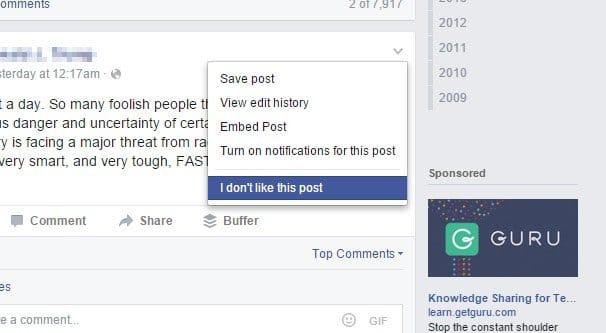 Written by ContentPowered.com
Written by ContentPowered.com
If you’re familiar at all with the way Facebook works, you know how important engagement is. If you don’t, allow me to enlighten you.
Facebook’s entire means of displaying posts to people is an algorithm called EdgeRank. According to Facebook themselves, if they didn’t filter your feed, you would see on average 1,500 stories per day. With the filtering, you see closer to 300.
The filtering algorithm was called EdgeRank back when it was simpler. They have tweaked it and made it more complex over the years, and the current algorithm is very different from what the original EdgeRank was, but that doesn’t matter. Since the new algorithm has no official name, people still called it EdgeRank.
The important thing to know is that EdgeRank is a constant calculation of affinity between two entities, be they profile or pages, on Facebook. If you are a page and you have 100 followers, you have at least 100 different “Edge Ranks,” one for each person. You’ll in practice has a lot more, as anyone who has visited your page but doesn’t follow you has an EdgeRank other than the default zero. So does anyone who has reported your page or blocked you.
There’s no way to see your EdgeRank rating with anyone else, so don’t worry about it. Instead, just learn what goes into the calculation and work to improve those metrics in general.
EdgeRank is calculated per post, and the type of post has an influence. Text posts aren’t very heavy, while links have more weight. Images have more, and videos have even more. This is why so many people post media on Facebook rather than just text posts; they’re seen more often by more people just by being media posts.
Additionally, you have timing as a metric. When you post, your time weight is at its peak. As time passes, the weight of the post decreases, with bumps when someone engages with the post. This is why old posts being resurrected can have a bump in visibility, but posts eventually fade regardless.
Finally, you have engagement. When a person views your page, follows you, likes your posts, comments on your posts, and shares your posts, these are elements of engagement. They increase affinity. You can try it yourself on Facebook; pick a business you follow but haven’t seen a post from in a while. Visit their page and comment on their most recent post. Now over the coming week, you’re virtually guaranteed to see more of their posts when they make them.
This is why you’re pursuing engagement; whenever someone engages, they’re ensuring that they’re going to see more of your content. The more people seeing more of your content, the better off you are. You’ll have higher reach, higher clicks, and higher conversions.
Engagement is good for your posts and it’s good for your relationship with users directly. However, negative engagement exists as well. When someone reports a post, reports your profile as a whole, or blocks you, they will see less of your content. Additionally, if you rack up too much negative engagement, it hurts your EdgeRank with everyone all around. It’s like a global modifier.
So now that you understand EdgeRank and engagement, you can start to diagnose why your engagement rates are dropping.
1. You Aren’t Posting As Frequently
More posting means more opportunities for engagement. Less posting means fewer opportunities. It goes beyond that, though, since I doubt you’re measuring your engagement per week. You’re measuring it per post, and that means you’re going to encounter highs and lows with your individual posts.
When you don’t post as frequently, people don’t engage as often. When people don’t engage as often, their EdgeRank decreases. This falls into a cycle where you feel like posting isn’t doing anything, so you post less and justify it, but it just further decreases your engagement.
The average lifespan of a low-engagement post is actually only about three hours. Engagement helps keep them alive, but posts that don’t get much engagement tend to fade quickly, which just means they have fewer chances at more engagement. There’s no resurrecting these posts; it’s better to make new ones.
2. Your Audience is Growing with Disinterested Users
In this case, I’m assuming you’ve been looking at engagement rate to determine that your engagement is dropping, rather than your engagement totals. Engagement rate is a measurement of the amount of engagement you get per person, which is generally quite low. An engagement rate of 1% is actually pretty good.
If you’ve been growing your audience recently, your engagement rate might have dropped. An increased audience size is nice, but if that audience is less interested in your business than your previous audience, you might be adding more disinterested users than interested.
If you have 1 out of 100 people engaging, and you add 150 people to get a second one engaging, you go from a 1% engagement rate to a 2/250 rate, which is .8%. You have more raw engagement, but a lower engagement rate.
3. Your Post Quality is Dropping
Sometimes I’ve seen businesses reach a holding pattern in their Facebook marketing. They have done their internal calculations and decided to expand into something like Twitter or Instagram rather than invest more into Facebook. They don’t want to let their Facebook presence fade, but they don’t put as much effort into it as they used to.
The static holding pattern means you’re putting less effort into your posts, which means they’re going to be less interesting an innovative on average. It also means that they’re not going to be as tested or as optimized. Both of these lead to posts that aren’t as engaging.
The longer you go about it, the less people will engage, and the less their engagement keeps them around. Remember, the longer a user goes without engaging, the less they see your posts. It’s a vicious cycle and it requires ads to kick you out of it.
4. You’re Not Posting Anything Interesting
How are your posts doing? Are they healthy? Have they been drinking their milk, eating their Wheaties? Your posts themselves may be the culprit. You need to be posting interesting, engaging content at all times if you want to keep your engagement rates up. Engagement rates aren’t like your audience. You can’t get them up to a specific level and leave it, resting confident that they’ll stay about where they were. Left idle, engagement rates are going to go down.
You need to do everything in your power to make sure your posts are as engaging as possible. This ranges from gimmicks like contest posts and offers, to questions and CTAs, to just curating great content. I recommend reading up on it.
5. You Changed Your Schedule
Followers, and people in general, like schedules. They like routine. If you get into a habit of posting every single day at 4pm, people are going to expect your posts at a given time around then. They might not mark their calendars, they might not care consciously about your schedule, but they’ll get used to seeing you and get used to interacting.
If you change your schedule, you lose out on two things. The first thing is the habit people form. If they expect a post and none exists, they’re maybe going to hunt for it, but maybe not. Many of them won’t, and that drops your engagement rate.
The other thing you lose is research into social media timing. I assume you have done your due diligence in figuring out when the best times of day to post are. If you change up when you post, you’re probably moving from a good position to a slightly worse position. This hurts your engagement as well.
6. You’re Posting Less Media
I mentioned above that different types of post tend to have different weights, with images and videos tending to be the best. This is partially due to Facebook wanting to push their own native video and image hosts rather than getting links from Imgur or YouTube or what have you. Facebook is encouraging you to upload your media natively.
If you start to post less media, your posts are going to have less weight to them as far as EdgeRank is concerned. This means fewer people see your posts over time, and fewer people are around to engage with them. It’s also possible that the people who do see them are on the less interested side of the scale, although ideally EdgeRank will self-correct to minimize that.
7. You Applied Narrow Post Targeting
No, I’m not talking about ads here. When you make a post with a Facebook page, you can actually control the audience that sees it to a certain extent. This isn’t guaranteed, like ad targeting, and it shouldn’t be. You’re not paying to limit your audience, you’re just giving Facebook guidelines of who you would prefer to see it.
The problem comes if you apply post targeting to organic posts, and then simply keep applying it without thinking of whether or not it’s the best custom audience for the job. This leads to plenty of instances where you’re targeting broadly relevant posts to a narrow audience, which decreases your engagement, reach, and otherwise beneficial actions. You’re limiting the visibility to people who you think would like it, when you’re not necessarily sure who really will.
8. You Posted Too Frequently and Were Reported
Posting too often leads to two different issues. The first issue is obvious; if you’re posting too much and you show up on someone’s feed too often, they might report you as something they don’t want to see or as spam. Both are detrimental, and mean you’re going to get lower reach and engagement, particularly if it happens too often.
The other issue is that you’re taking up valuable slots with less valuable posts. Remember how 4/5ths of the posts people would see are filtered? Well, you can’t really just shove yours through by posting more often. You’re just going to be posting more filtered posts. Then the chances of the good one getting through are smaller, so you get less engagement on every post and even less on the ones that matter most.
9. Your Post Content is Repetitive
This goes hand in hand with the previous issue. If you’re posting more often, you’re likely doing it so you can get more instances of your sales pitch out there where people can see them. Even if you’re not, you’re probably promoting something.
This is a detrimental action on Facebook. Facebook and Facebook users both dislike repeated advertising, particularly through organic posts. Facebook is okay with it via ads, though even then they warn you about too high an ad frequency.
Dial back on posting the same thing repeatedly, especially if that same thing is a link or image. Think about it this way; if someone visits your feed and sees four instances of the same post, are they going to want to follow you?
10. A New Competitor Arrived
Sometimes you haven’t done anything differently. You’re still posting they way you used to. You’re still researching, you’re still creating good posts, you’re just not getting the engagement you used to be.
Check Facebook for competitors. There’s only so much attention to go around, and a new competitor can sap some attention from you. Unfortunately, there’s nothing you can do to prevent it entirely. You just have to strive to be even better, so they struggle to take traffic away from you.
11. You’re Not Asking for Engagement
One of the easiest ways to get engagement from users on any social network is simply to ask for it. You can say “please retweet” on Twitter, you can ask for users to “share this post” on Facebook, and the like. It actually works, and you might be surprised at how well it works. Sometimes it really is that easy; all you need to do is ask.







